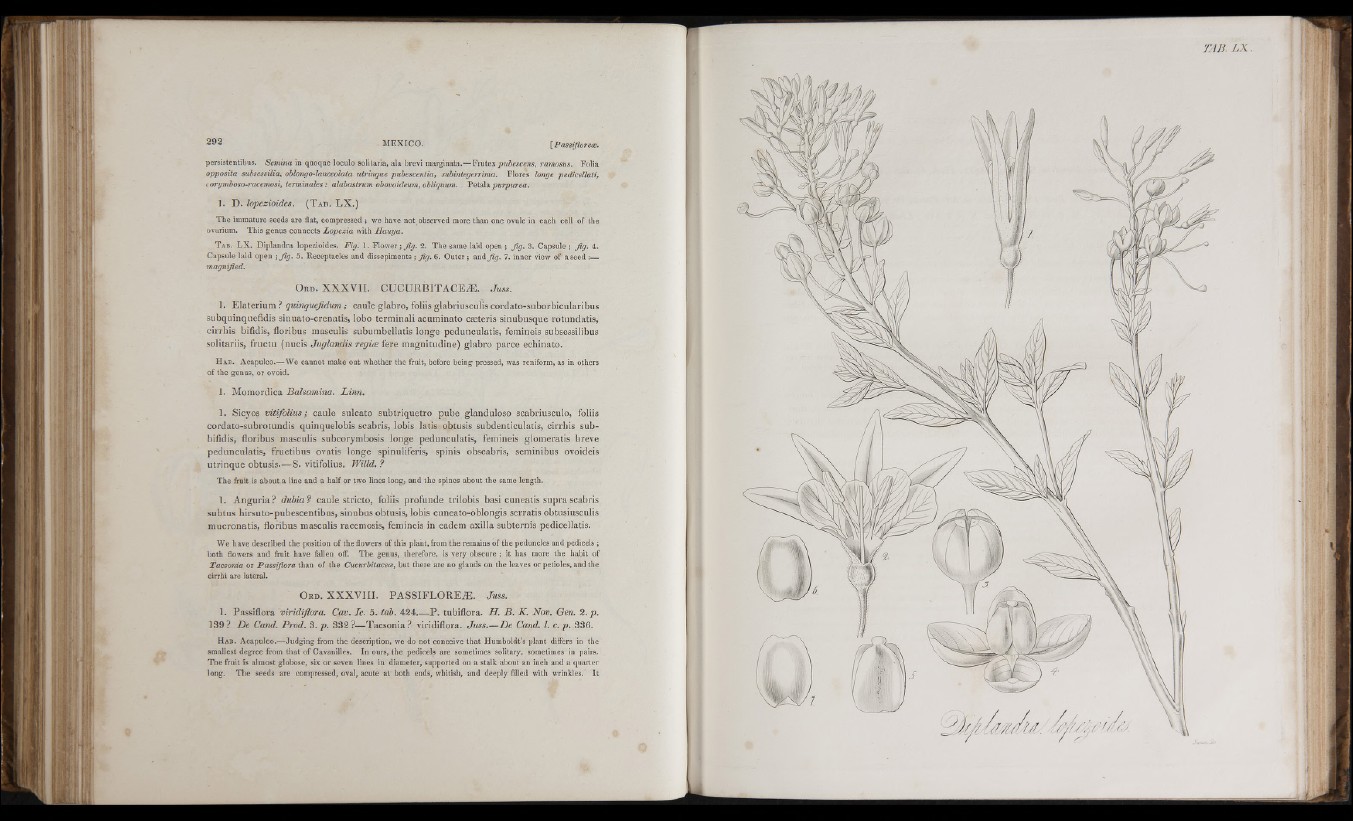
î' il ui
persistentibus. Semina in queque loculo solitaria, ala brevi marginata.— Frutes pwiescews, ramosus. Folia
opposita subsessilia, oblongo-lanceolata utrinque pubescentia, subintegeirima. Flores longe pedicellati,
c orymboso-racemosi, terminales : alabastrum obovoideum, obliquum. Petala puipurea.
1. T>. lopezioides, (T a b . L X .)
The immature seeds are flat, compressed ; we have not observed more than one ovule in each cell of the
ovurium. This genus connects Lopezia avith Hauya.
T a b . LX. Diplandra lopezioides. Fig. 1. Flower ; fig . 2 . The same laid open ; fig . 3 . Capsule ; fig . 4 .
Capsule laid open ; fig . 5. Receptacles and dissepiments ; fig . 6. Outer ; and fig . 7. inner view of a seed :__
magnified.
O r d . X X X V I I . C U C U R B IT A C EÆ . Juss.
1. E la te rium ? guinquefidum ; caule glabro, foliis glabriusculis cordato-suborbicularibus
subquinquefidis sinuato-crenatis, lobo terminali acuminato cæteris sinubusque rotundatis,
c irrh is bifidis, floribus masculis subumbellatis longe pedunculatis, femineis subsessilibus
solitariis, fructu (nucis Jiiglandù regiæ fere magnitudine) glabro p arce echinato.
H a b . Acapulco.—We cannot make out whether the fruit, before being pressed, was reniform, as in others
of the genus, or ovoid.
1. Momordica Balsamina. Linn.
1. Sicyos vitifolius; caule sulcato subtriquetro pube glanduloso scabriusculo, foliis
cordato-subrotundis quinquelobis scabris, lobis latis obtusis subdenticulatis, cirrhis sub-
bifidis, floribus masculis subcorymbosis longe pedunculatis, femineis glomeratis breve
pedunculatis, fructibus ovatis longe spinuliferis, spinis obscabris, seminibus ovoideis
u trin q u e obtusis.—S. vitifolius. Willd. ?
The fruit is about a line and a half or two lines long, and the spines about the same length.
1. A n g u ria ? duhia? caule stricto, foliis profunde trilobis basi cuneatis su p ra scabris
subtus hirsuto-pubescentibus, slnubu.s obtusis, lobis cuneato-oblongis serratis obtusiusculis
m ucronatis, floribus masculis racemosis, femineis in eadem axilla subternis pedicellatis.
We have described the position of the flowers of this plant, from the remains of the peduncles and pedicels ;
both flowers and fruit have fallen off. The genus, therefore, is very obscure ; it has more the habit of
Tacsonia or Passiflora than of the Cucurbitacece, but there are no glands on the leaves or petioles, and the
cirrbi are lateral.
O r d . X X X V I I I . P A S S IF L O R E Æ . Juss.
1. Passiflora viridifiora. Cav. Jc. 5. tab. 424.— P . tubiflora. H . B. K. Nov. Gen. 2. p .
139? De Cand. Prod. 3. p. 3 3 2 ?— T a c so n ia ? viridifiora. Juss.—De Cand. I. c. p. 336.
H a b . Acapulco.— Judging from the description, we do not conceive that Humboldt’s plant differs in the
smallest degree from that of Cavanilles. In ours, the pedicels are sometimes solitary, sometimes in pairs.
The fruit Is almost globose, six or seven lines in diameter, supported on a stalk about an inch and a quarter
long. The seeds are compressed, oval, acute at' both ends, whitish, and deeply filled with wrinkles. It
7-IB. ! .X .
i r '. '
I f I
If :
H ;
U ■ * 1